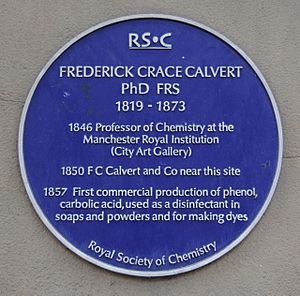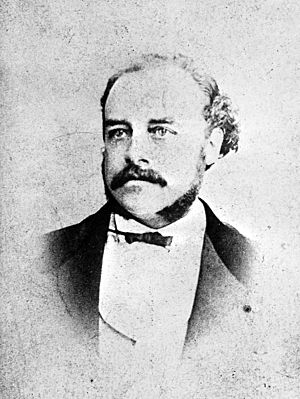Frederick Crace Calvert facts for kids
Frederick Crace Calvert (born November 14, 1819 – died October 24, 1873) was an important English chemist. He was born near London. His work helped improve many industrial processes, especially in the chemical field.
Contents
Early Life and Studies
Frederick Crace Calvert spent about ten years, from 1836 to 1846, living in France. While there, he studied chemistry in Paris. After his studies, he became a manager at some chemical factories. He also worked as an assistant to a famous French chemist named Michel Eugène Chevreul. This experience gave him a strong background in practical chemistry.
A Career in Industrial Chemistry
When Frederick Crace Calvert returned to England, he settled in Manchester. He became a consulting chemist, which meant he advised companies on chemical processes. He was also given the title of honorary professor of chemistry at the Royal Manchester Institution.
He focused most of his career on industrial chemistry. This type of chemistry deals with making useful products on a large scale for industries.
Working with Coal-Tar Products
Calvert spent a lot of time studying products made from coal-tar. Coal-tar is a thick, black liquid that comes from coal. He was especially interested in carbolic acid.
The Importance of Carbolic Acid
Carbolic acid was very important for treating raw sewage. Sewage is wastewater from homes and industries. Treating it helps keep our environment clean and prevents diseases. In 1865, Calvert even started a large factory in Manchester to produce carbolic acid.
Sharing His Knowledge
Besides his work in factories, Frederick Crace Calvert also wrote many articles. These articles appeared in scientific journals in both England and France. He also wrote a book called Dyeing and Calico-Printing. This book shared his knowledge about how to dye fabrics and print patterns on them.
Legacy and Recognition
Frederick Crace Calvert passed away in Manchester. His contributions to chemistry were very significant. Today, he is remembered with a special blue plaque from the Royal Society of Chemistry. This plaque is located on Princess Street in Manchester. It honors his important work and discoveries.



